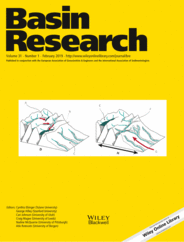
Full text loading...
 , Rui Li2, Pieter Vermeesch4, Xilin Sun2, Yong Li1, Martin Rittner4, Andrew Carter5, Chongjian Shao1, Hu Huang1, Xiangtian Ji1
, Rui Li2, Pieter Vermeesch4, Xilin Sun2, Yong Li1, Martin Rittner4, Andrew Carter5, Chongjian Shao1, Hu Huang1, Xiangtian Ji1
The Sichuan Basin and the Songpan‐Ganze terrane, separated by the Longmen Shan fold‐and‐thrust belt (the eastern margin of the Tibetan Plateau), are two main Triassic depositional centres, south of the Qinling‐Dabie orogen. During the Middle–Late Triassic closure of the Paleo‐Tethys Ocean, the Sichuan Basin region, located at the western margin of the Yangtze Block, transitioned from a passive continental margin into a foreland basin. In the meantime, the Songpan‐Granze terrane evolved from a marine turbidite basin into a fold‐and‐thrust belt. To understand if and how the regional sediment routing system adjusted to these tectonic changes, we monitored sediment provenance primarily by using detrital zircon U‐Pb analyses of representative stratigraphic samples from the south‐western edge of the Sichuan Basin. Integration of the results with paleocurrent, sandstone petrology and published detrital zircon data from other parts of the basin identified a marked change in provenance. Early–Middle Triassic samples were dominated by Neoproterozoic (~700–900 Ma) zircons sourced mainly from the northern Kangdian basement, whereas Late Triassic sandstones that contain a more diverse range of zircon ages sourced from the Qinling, Longmen Shan and Songpan‐Ganze terrane. This change reflects a major drainage adjustment in response to the Late Triassic closure of the Paleo‐Tethys Ocean and significant shortening in the Longmen Shan thrust belt and the eastern Songpan‐Ganze terrane. Furthermore, by Late Triassic time, the uplifted northern Kangdian basement had subsided. Considering the eastward paleocurrent and depocenter geometry of the Upper Triassic deposits, subsidence of the northern Kangdian basement probably resulted from eastward shortening and loading of the Songpan‐Ganze terrane over the western margin of the Yangtze Block in response to the Late Triassic collision among Yangtze Block, Yidun arc and Qiangtang terrane along the Ganze‐Litang and Jinshajiang sutures.

Article metrics loading...

Full text loading...
References


Data & Media loading...
Supplements

